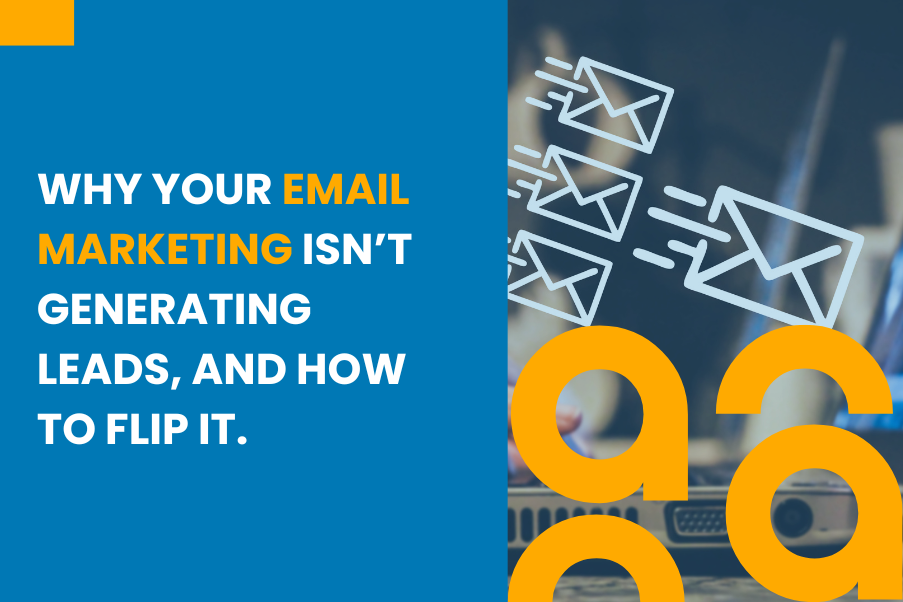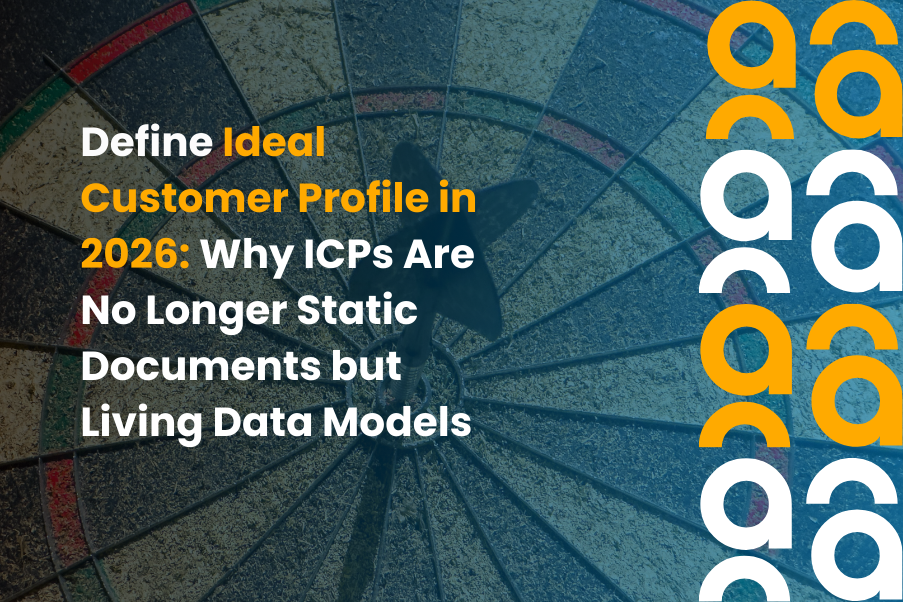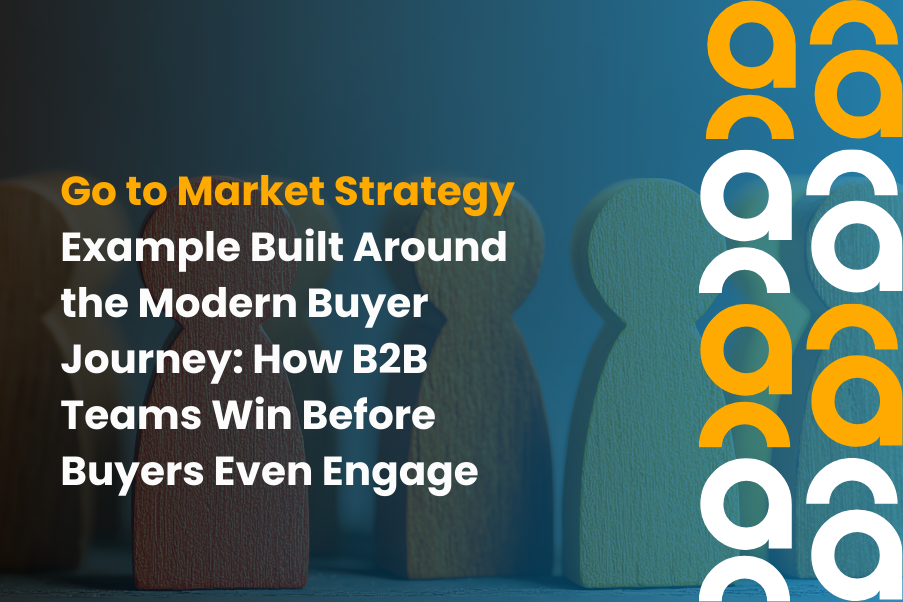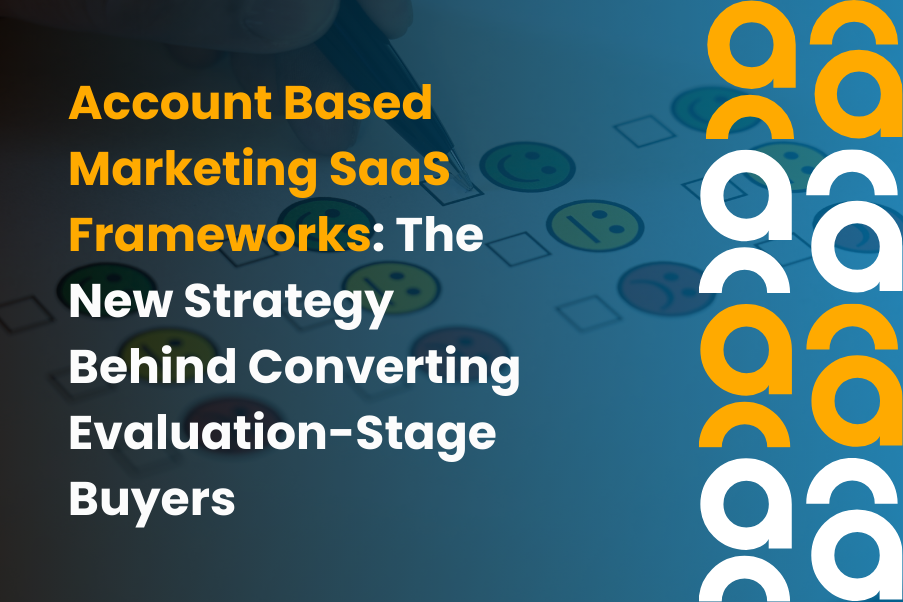Why Your Email Marketing Isn’t Generating Leads - And How to Flip It

Introduction
If your team keeps sending out batches of emails and watches open rates drop, you’re on familiar ground. When email marketing for B2B stops producing leads, the root cause rarely lies in simply sending emails. It lies in how you send them in your segmentation, timing, messaging, follow-up, and data flow.
In this blog, we’ll explain the common pitfalls seen in B2B Email Campaigns, along with a step-by-step playbook to reverse the trend and start generating measurable leads. Every tip continues to center around email marketing for B2B, so you always know how the idea connects to the outcome. Let’s begin!
Mistake #1: Poor audience segmentation and weak relevance
A frequent error lies in assuming one email fits all. In the B2B space, your audience includes senior decision-makers who expect high-level insight, mid-level influencers craving technical specifics, and early-stage leads who need education rather than a sales push. When you send a generic message to the entire list with no segmentation, you risk losing relevance for all these groups.
Studies show more detailed segmentation aligns with roughly 30% higher open rates and about 50% more clicks when compared to non-segmented campaigns.
What to fix
- Build segments by criteria such as company size, role, buying stage, and prior engagement. Use your list to map the intent behind the send, aligning with email marketing tips that emphasize this.
- Create content for each persona segment: senior executives get high-impact insight, technical leads get depth, and early-stage leads get educational value. This forms a solid foundation for your b2b email marketing strategy.
- Use dynamic content blocks where your platform allows. Each recipient may see content suited to their segment within a single send, aligning with email marketing for B2B best practices.
- Maintain a swipe file of strong examples in your niche to understand what counts as the best b2b emails.
Keep your segmentation strategy closely tied to email marketing for B2B so your list supports pipeline growth, not vanity metrics.
Mistake #2: Inadequate send timing and cadence
Even with strong content, outcomes suffer if timing or cadence are off. If you send too often, you fatigue your list. If too rarely, you’re forgotten. Many programs still use batch-and-blast methods without mapping cadence to buyer behavior.
Email remains a dominant B2B lead-generation channel, with 88% of businesses using email in their campaigns. Yet many of these efforts fail because outreach is mistimed or irrelevant.
What to fix
- Audit your send frequency and segment by engagement: high-engagement segments can receive more frequent sends, while low-engagement segments receive fewer.
- Trigger sends based on user behavior, such as a download, webinar sign-up, or page visit. These are hallmarks of B2B Email Campaigns that align with buyer actions.
- Develop an evolving send calendar that ties into your b2b email marketing strategy, rather than rigid monthly blasts.
When cadence matches buyer behavior, your outreach follows motion, not guesswork.
Mistake #3: Weak follow-up sequences and lack of nurture
Many B2B content syndication vendors talk about delivering a huge number of leads. But quality matters more than volume.
Ask them to share case studies from campaigns similar to yours and check how many of those leads actually turned into marketing-qualified or sales-ready prospects.
Research shows that most syndicated leads need additional nurturing before they are ready for sales, so it is important to have a strong follow-up plan to protect your ROI.
Know What You’re Paying For
In B2B, a single email rarely triggers a purchase. Decision cycles often span weeks or months. Many programs treat email as a one-and-done task, causing good leads to disengage because they never receive proper nurture or follow-up.
Consider this: 48% of marketers say email is their most effective lead generation tactic. If email is doing the heavy lifting, the absence of follow-up means you’re leaving results on the table.
What to fix
- Build a multi-stage journey: welcome message, value-driven content, case study, invitation to connect, and reminder.
- Assign each stage a clear goal, such as driving clicks or booking meetings. This is central to email marketing for B2B that drives engagement and conversions.
- Align sales and marketing so handoffs happen at the right moment.
- Use email marketing tips that focus on prompting replies and simplifying next steps.
- Review examples of the best b2b emails to see how they move a reader toward a call without being forceful.
Keep alignment between email marketing for B2B and your nurture series so the buyer’s journey remains clear for both your team and your leads.
Mistake #4: Lack of personalization and content relevance
Generic content weakens lead generation. In a crowded B2B inbox, one-size-fits-all messaging fades fast. Audits show around 90% of tested emails had design or accessibility issues, and nearly 96% contained content errors such as broken links or formatting problems.
What to fix
- Use dynamic fields like first name, company name, and role-relevant details if your platform supports it.
- Start with a specific pain point or event that your audience recognizes. This approach aligns with b2b email marketing best practices.
- Share case studies, real examples, and data instead of broad claims.
- Test emails across devices, check all links and visuals, and store the best-performing layouts as internal benchmarks for your B2B Email Campaigns.
- Keep a swipe file of the best b2b emails that earned high engagement.
When your content aligns with audience context, email marketing for B2B starts producing stronger results.
Mistake #5: Missing data-driven optimization and measurement
Without active tracking, even well-written campaigns lose momentum. Effective email marketing for B2B demands visibility into opens, clicks, replies, and conversions.
What to fix
- Set up dashboards to track open rates, click-throughs, replies, and meetings booked.
- Run A/B tests on subject lines, send times, and copy variations.
- Regularly clean your database by removing inactive contacts. This is an essential part of b2b email marketing best practices.
- Share team-wide reports on what worked, keeping your email marketing tips in circulation.
- Connect every optimization to an objective in your b2b email marketing strategy so progress compounds.
A playbook to flip your email marketing for B2B
Step 1 – Define your ideal target and segment list
Map buyer personas by role, title, industry, and company size. Use your CRM and behavioral data to assign segments. This foundation builds the base for outreach that connects.
Step 2 – Build relevant content for each segment
For each segment, identify:
- The main problem they’re facing
- The value your solution provides
- The next logical step, such as a demo or meeting
This is how your b2b email marketing services turns into a two-way conversation.
Step 3 – Design your email sequence
- Email 1: Value proposition or insight to capture interest
- Email 2: Case study or proof point, sent a few days later
- Email 3: Invitation to a meeting or live demo
- Email 4: Reminder to those who clicked but didn’t convert
Capture email marketing tips learned from each wave so your next send improves.
Step 4 – Test timing and frequency
Start with a moderate cadence, such as one email per week for active leads. Track engagement by send day and time, then adapt. This approach turns B2B Email Campaigns into data-led efforts.
Step 5 – Clean, personalize, and refine
Segment lists by engagement level, remove or re-engage inactive leads, and use dynamic fields for personalization. Test designs and links across devices to keep your b2b email marketing best practices sharp.
Step 6 – Monitor and optimize
Track which emails generate meetings or conversions. A/B test content, CTAs, and subject lines. Archive underperformers and scale winners. Build an internal library of the best b2b emails to model future sends.
Keep email marketing for B2B aligned to sales stages so every email has a purpose and every metric drives the next move.
How we help at Almoh Media
At Almoh Media, we specialize in B2B lead generation, including end-to-end support for email marketing for B2B.
Our services include:
- Strategic ICP profiling and segmentation to align your database with the right decision-makers.
- A structured b2b email marketing strategy defining content, cadence, and channels mapped to the buyer journey.
- Campaign creation centered around hyper-personalized communication that focuses on real pain points, modeled after the best b2b emails.
- Automation, tracking, and follow-up workflows that turn opens into meetings and meetings into qualified leads across B2B Email Campaigns.
- Ongoing optimization supported by practical email marketing tips linked directly to your pipeline.
You can learn more about how we help generate quality leads B2B lead generation services. Every service we provide ties directly to measurable outcomes in email marketing for B2B.
Conclusion
If your email marketing for B2B is not generating leads, the problem can be solved. Start by reviewing segmentation, content, and cadence.
Ask yourself: “Are my nurture sequences built for conversion?” and “Is my measurement framework truly active?”If any of these answers are unclear, it’s time for a reset.
Contact Almoh Media today and let us craft a high-performing email strategy for your brand. Our team combines the best of b2b email marketing strategy, effective B2B Email Campaigns, and actionable email marketing tips you can use immediately.
The goal is simple: create email marketing for B2B that generates conversations, meetings, and results – not just opens.
Introduction
If you’re using content syndication, chances are you see it as just another way to get your content in front of more eyes. That’s fine, but there’s a lot more hidden beneath the surface. When you allow its full potential, content syndication ROI can surprise you, and it doesn’t take much to shift perception.
Let’s look at fresh data, outline a winning content syndication strategy, and show how U.S. B2B teams can get real value from it. Let’s begin!
What Is Content Syndication?
At its simplest, content syndication means sharing your B2B content: whitepapers, case studies, blogs on someone else’s site or network. This can be paid or free. You expand your reach, tap into new networks, and generate visibility, often reaching audiences you’d otherwise miss.
Why ROI From Content Syndication Deserves a Second Look
1. Huge lead production for relatively low spend
According to recent studies, the average cost per lead with content syndication is around $43. That’s far lower than other tactics, so even moderate conversion rates can offer solid returns.
2. Fast pipeline growth
Some platforms report that customers see 300–500% return on investment within three years. That’s not fluff – it’s real pipeline growth.
3. Verified conversion tracking methods
With UTM tagging and targeted vendor reports, U.S. marketers can track everything from initial syndication click to closed deal.
4. Built-in trust and positioning
Syndicating through known sites can give you indirect credibility, boosting brand awareness and authority without extra effort.
B2B Content Syndication Strategy: How to Do It Right
A good content syndication strategy starts long before content hits a third-party platform:
a). Pick assets that matter
Whitepapers, case studies, and long-form guides work best. They not only attract interest but also help establish your brand as industry-relevant.
b). Target lead quality, not rush volume
Instead of chasing clicks, target professionals. For example, top B2B firms average a 5.31% conversion rate on syndication offers.
c). Tag everything with UTM links
Measure traffic, engagement, bounce rates, and conversions back at your URL. This helps with syndication attribution.
d). Track core metrics
- CPL (cost per lead)
- MQL-to-SQL conversion rates
- Revenue per lead (use your average contract value)
e). Use the ROI formula
ROI= Revenue−Spend
Spend
For example, $1,000 spent → 50 high-quality leads → $5,000 average value = ($250k – $1k)/$1k = 249× ROI.
f). Optimize, rinse, repeat
Check what works by audience, site, and format. Then double down and drop what doesn’t.
Concrete U.S. ROI Stats You Can’t Ignore
| Metric | Statistics/Insight |
| Cost per lead | $43 average CPL |
| Syndication conversion rate | ~5.31% typical |
| Lead-to-deal conversion lift | 45% increase when focus is on quality |
| ROI over 3 years | 300%–500% reported |
| Projected industry growth | From $4.7 B in 2022 to $5.9 B by 2030 |
Content Syndication for Lead Gen: A Step‑by‑Step Plan
1. Define your ideal audience
Use buyer personas: titles, sectors, company size – so your content finds the right hands. This way, a sharper audience focus helps eliminate wasted spend and improves downstream lead quality.
2. Pick content with substance
Original research, how-to guides, competitive whitepapers – these both educate and convert. Plus, assets that solve specific problems tend to drive stronger engagement and more intent-driven leads.
3. Choose partners wisely
Use third-party platforms to reach U.S. B2B audiences. Look for those offering clear lead reporting and media kits. Before moving forward, ask for case studies or past performance metrics to make a more informed decision.
4. Structure campaigns with UTM tags
Make distinct tracking links for each partner and asset. This makes sure it’s easier to attribute leads, identify top performers, and compare ROI across channels.
5. Launch and monitor
Track CPL, CPL-to-SQL, cost per opportunity, pipeline driven, and revenue tied. At the same time, monitor activity in real-time to catch early trends and shift strategy fast if needed.
6. Review and refine monthly
Use metrics to shift spend toward top performers and tweak underperformers. As a result, consistent optimization keeps your syndication efforts aligned with revenue goals, not just vanity metrics.
How to Calculate Content Syndication ROI
- Calculate total spend (vendor fees + internal costs).
- Count total leads.
- Multiply leads by average deal size for potential revenue.
- Apply the ROI formula:
Revenue−Spend
Spend - Compare ROI over time to benchmark your initiatives.
This method is backed by multiple calculators and case studies.
Hidden Content Syndication Benefits
- SEO gains: Backlinks from quality sources can raise domain authority.
- Brand authority: Recognition on respected sites = credibility.
- Extended content life: A blog post can live on for months if syndicated well.
- Nurture acceleration: Leads from syndication are often further along in buying cycles.
Mistakes to Avoid and Fix Fast
Mistake: Only tracking clicks, not deals.
Fix: Tie every lead back to conversions with CRM integration. That way, you get a clearer picture of what’s actually driving revenue, not just traffic.
Mistake: Focusing only on cheap volume.
Fix: Go after quality; MQL-to-SQL rates matter most. Otherwise, your sales team will waste time on leads that won’t convert.
Mistake: Publishing irrelevant content.
Fix: Audit content – ensure tone, relevancy, and depth match syndication partner audiences. In doing so, you increase the chances of your content resonating with the right decision-makers.
Mistake: Not optimizing over time.
Fix: Regular performance review. Cut poor performers, boost winners. Over time, this helps improve ROI and keeps your content syndication strategy focused and results-driven.
Why Lead Quality Beats Volume
Not all leads are created equal. A smaller batch of high-intent leads can drive more revenue than a huge pool of low-interest ones.
Many B2B brands in the USA are shifting toward account- based syndication, where campaigns are matched to specific industries or companies. This helps improve conversion rates, shorten sales cycles, and increase customer lifetime value.
In short, prioritizing lead quality helps improve the long-term content syndication ROI, especially when targeting high-ticket accounts.
How AI Is Shaping the Future of Syndication
AI tools are starting to reshape content syndication strategy by analyzing behavior patterns and automating placements across high-performing channels.
With predictive scoring, marketers can now:
- Match content formats to individual user segments
- Forecast lead readiness using engagement scores
- Automate syndication at scale using content intent data
These innovations are raising the ceiling on what’s possible for B2B content syndication, especially for companies focused on measurable results.
About Almoh Media
Use metrics to shift spend toward top performers and tweak underperformers.
As a result, consistent optimization keeps your syndication efforts aligned with revenue goals, not just vanity metrics.
At Almoh Media, we specialize in high-impact content syndication for lead gen. We help B2B companies in the U.S. grow their pipelines by delivering:
- Verified lead generation from trusted channels
- Industry-specific targeting and campaign setup
- Transparent reporting tied to your sales funnel
- A proven strategy backed by real ROI
We understand the U.S. B2B buyer journey, and our syndication campaigns are built to generate demand, not just clicks.
Final Takeaway
Content syndication is an easy win if done smartly.
Focus on:
- Quality, not just volume
- Clear tracking and attribution
- Lead-to-deal conversions
- Continuous optimization
With $43 CPL, 5+ percent conversion, and long-term returns of 300–500%, most U.S. B2B teams can justify putting more budget behind it.
Ready to Get Real ROI from Content Syndication?
Let Almoh Media help you build a smarter lead-gen machine. We bring strategy, scale, and precision to content syndication – so your campaigns don’t just get seen; they convert. Reach out now to get started.
-
 Define Ideal Customer Profile in 2026: Why ICPs Are No Longer Static Documents but Living Data Models
Define Ideal Customer Profile in 2026: Why ICPs Are No Longer Static Documents but Living Data Models -
 Go to Market Strategy Example Built Around the Modern Buyer Journey: How B2B Teams Win Before Buyers Even Engage
Go to Market Strategy Example Built Around the Modern Buyer Journey: How B2B Teams Win Before Buyers Even Engage -
 Account Based Marketing SaaS Frameworks: The New Strategy Behind Converting Evaluation-Stage Buyers
Account Based Marketing SaaS Frameworks: The New Strategy Behind Converting Evaluation-Stage Buyers -
 What 2026’s Best-Performing Teams Do Differently when it comes to B2B Account-Based Marketing Campaigns
What 2026’s Best-Performing Teams Do Differently when it comes to B2B Account-Based Marketing Campaigns -
 B2B Account Based Marketing in an Over-Messaged World: The Rise of Context-First Personalization
B2B Account Based Marketing in an Over-Messaged World: The Rise of Context-First Personalization

